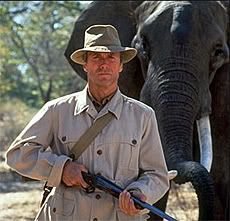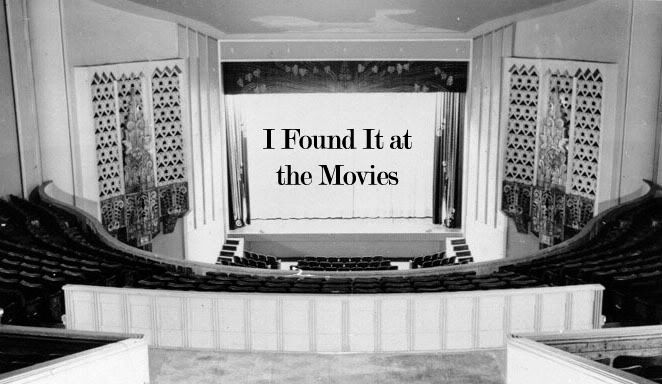
WHITE HUNTER BLACK HEART (Clint Eastwood, 1990)
The iconic representation of Clint Eastwood the actor is pretty straightforward. Thanks to roles in Sergio Leone’s spaghetti westerns and the Dirty Harry movies, Eastwood the actor seems to be a new John Wayne: terse, reserved, and gravelly-voiced, the epitome of masculinity defined through simple, violent action. When Dirty Harry was released in 1971, Eastwood quickly encapsulated the reactionary nihilism which informed 1970s conservative ideology. Liberals decried him, conservatives celebrated him. And Eastwood—a registered Republican—neither embraced nor shunned this categorization.
One has only to look at Eastwood the director to uncover an entirely more complicated animal. To date, Eastwood has directed 27 films. Some are acknowledged classics (Unforgiven, Mystic River), many generic waste (Bronco Billy, Honkeytonk Man, The Bridges of Madison County, True Crime), even others critics’ darlings (Bird, White Hunter Black Heart, Letters from Iwo Jima). Can one find common threads woven between these films, signposts that scream, “This is an Eastwood film?” One can. Clint Eastwood is a director whose goal has been to quietly invert the tropes and moral subtexts of classical genres. Sometimes he succeeds, often times he fails, but he has constantly had the same taste for revisionism as Altman, Scorsese, and Fuller, among others.
If Bird tackled the biopic, Unforgiven the western, Mystic River the cop thriller, Million Dollar Baby the boxing picture, and Letters from Iwo Jima the war movie, then one of Eastwood’s less-acknowledged successes, White Hunter Black Heart, takes aim at the adventure film (I’ve deliberately referenced films from the most recent half of Eastwood’s career as a director; it’s the half where I believe he has truly come into his own as an artist, and developed his thesis on genre to its fullest potential). Based (not so) implicitly on the making of Huston’s The African Queen, Eastwood plays John Wilson, a megalomaniacal film director with a massive lust for life. He takes his friend and screenwriter Pete Verrill (Jeff Fahey) on safari in Africa before the shooting for his new picture is scheduled to begin. He keeps delaying doing anything about the making of the film, desiring only to hunt for an elusive bull elephant whose tusks reach all the way to the ground. In fact, actually making the film is the furthest thing from his mind. He eventually becomes consumed by hunting this elephant, for no other reason than merely to do it. When his beloved guide Kivu is gored by this legendary “big tusker,” Wilson finally snaps out of his mania and sets out to direct the picture.
Eastwood could very easily have made a rip-roaring adventure story, full of close calls, ravishing dames, and cheap native stereotyping. However, he avoids all that, but uses a style that is still reminiscent of the elder genre masters (Hawks, Ford, especially Huston). Eastwood has a canny ability to both embrace and subvert generic tropes; it is irony of the gentlest kind. His image of Huston is loving but also highly critical. A man who embraces hedonism merely for the sake of experiencing new sensations, with no regard to his friends, can be seen as a romantic—a good old iconoclast—but he can also be seen as reckless, arrogant, narcissistic, and boorish. Eastwood captures both sides of Huston’s persona, as well as incorporating the personalities of men who Huston admired most. A very telling scene involves Verrill reciting new dialogue he’s written (lifted verbatim from The Africa Queen's script). Wilson shakes it off, demanding that subplot and character sacrifices the essentiality of the story. Hemingway, Stendhal, Melville; these men kept things simple, direct, powerful. And while no one could deny the power of those writers, Wilson is rebuking possibility in art. Eastwood’s performance is highly calculated to illuminate both an embrace of and commentary upon his subject(s). (Jonathan Rosenbaum has called Eastwood’s technique “Brechtian,” but I’m not sure yet if Eastwood’s tone qualifies him for that label.)
How does Eastwood achieve this tonal feat? As in his best movies—Bird, Unforgiven, Mystic River, Letters from Iwo Jima—he combines elements into an almost elegantly classical synthesis. He enjoys dynamic lighting contrasts, but conveys them softly, rather than harshly (a la film noir). His camera remains stationary, often employing plains americans shots. When the camera does move, it glides, almost lilting along without any elaborate or rapid movement (Scorsese, Welles, Renoir, Murnau); ditto his editing, a sequence of shot patterns that gently adhere to classical rules (for the most part, anyway). Eastwood is not a radical modernist, or even post-modernist; at least not in the fashion of the majority of the filmmakers to whom we could ascribe those titles. His closest thematic and stylistic counterparts are Sam Fuller and Akira Kurosawa, but even they are more stylistically brash than Eastwood could ever hope to be.
Eastwood is also not as tightly schematic a filmmaker as his revisionist counterpart, Robert Altman. One could definitely say Altman was gentle and subtle in his deconstruction of cinematic genre, but he broke more sharply with classical form. And it is rare that one senses a great deal of admiration for the genres Altman eviscerates. Altman was a filmmaker who used his gentleness to allow his scathing anger to cut through more directly. Despair is the overriding feeling in Altman’s best work; sadness is what informs Eastwood’s.
The pivotal moment in White Hunter Black Heart which sets up the tragedy of the ending comes the night before the crew is set to begin filming Wilson’s picture. Verrill confronts him about why he would want to kill one of the most beautiful and noble animals on the planet, and at the expense of his friends and colleagues. He equates Wilson’s hunt with “committing a crime.” But Wilson goes further than that: with the camera tightly placed upon his face half-covered in ominous shadow, he says it’s not a crime, but a sin. To kill an elephant is a rupture and affront to everything good in this world. But it is because it is a sin that Wilson must do it. His hedonism is so profound that he doesn’t even understand it, and must submit to its power. The next morning, when Wilson finally understands where his mania has brought him, the person in whom he had placed his trust the most—Kivu—essentially dies for him.
Another genre one could say Eastwood attacks in addition to the adventure film is the White Man in Africa film, a subgenre only now beginning to be investigated, thanks to films like Out of Africa, The Constant Gardener and Blood Diamond, just to name a few. Typically, these message movies claim to bring the injustices of Africa to light in the western world, but usually pander to the guilt of the films’ white liberal audiences, in addition to exploiting Africa as much as the people they purport to condemn. White Hunter Black Heart does not allow for a clean narrative resolution to the rupture to African life which Wilson and his crew represent. To further complicate the matter, Wilson—on some levels—does love and respect African life on its terms, wishing to be part of, rather than impose upon, it. His exploits, however, still manage to cause damage to the way of life there, with tragic consequences. Eastwood lets this tragedy hang in the air as the film finally concludes, making us ponder just what it was about Africa that drove Wilson in the first place. Eastwood again embraces and undercuts the notion of the White Man in Africa.
It is difficult to disconnect style from content in an Eastwood film; the one informs the other. Eastwood manages to synthesize the two, causing a totality of tone, which often doesn’t reveal itself unless deeply pondered upon. Altman and Fuller painted in broadstrokes and violent colors in films like McCabe & Mrs. Miller and Forty Guns. Eastwood is soft, muted, and almost impressionistic in Unforgiven. This gentle subtlety can often collapse into itself (like in Million Dollar Baby or Midnight in the Garden of Good and Evil), but in masterworks like White Hunter Black Heart, they reveal the deeply profound—and sometimes confounding—complexity of the world.


1 comment:
Hi, Scorsese is not a revisionist. You can add vulgarity/swearing/nudity/violence to formula/genre and achieve no progressivism at all.
Post a Comment